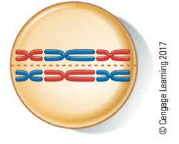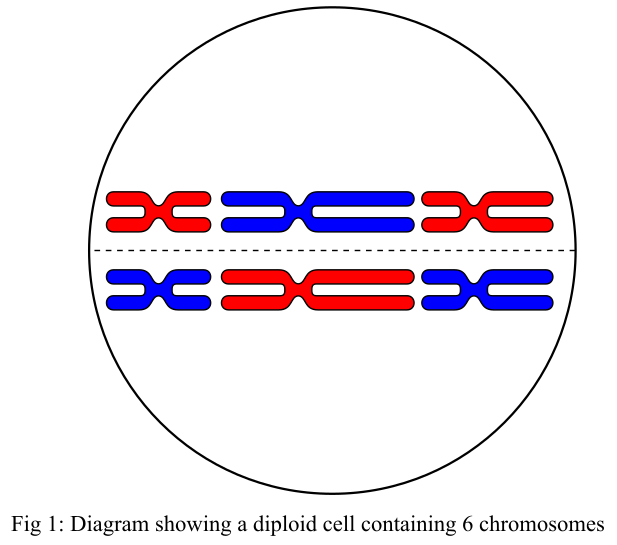
Concept explainers
The chromosome constitution number of this individual is

This drawing represents:
a. mitotic metaphase.
b. meiotic metaphase I.
c. meiotic metaphase II.
d. a gamete.
e. sixnonhomologous chromosomes.
Introduction:
The cell cycle consists of two main divisions known as mitosis and meiosis. Mitosis is the first division during the cell cycle in which the number of chromosomes remains same as the number of chromosomes in the parent cell; on the contrary, in meiosis, the number of chromosomes gets reduced to half.
Answer to Problem 1TYK
Correct answer:
Metaphase 1 of meiosis.
Explanation of Solution
Justification for the correct answer:

Option (b) is meiotic metaphase 1. There are two meiotic divisions after mitosis, namely, meiosis 1 and meiosis 2. During the meiosis 1, the paired chromosomes, also known as bivalent, arrange themselves on the metaphase plate. These paired chromosomes align at the middle of the plate and get attached to the meiotic spindle. The spindle is formed from the structure of the protein, which is responsible for dividing the genetic material in the cell. Hence, option (b) is correct.
Explanation for the incorrect answer:
Option (a) is metaphase in mitosis. Mitosis is the first part of the cell cycle that takes place before the meiosis. Metaphase stage in mitosis involves the arrangement of most condensed chromosomes and these chromosomes then get coiled at this stage. During the metaphase stage of meiosis, the chromosomes are not paired. So, it is an incorrect option.
Option (c) is metaphase 2 phase of meiosis 2. The chromosomes in the meiosis 2 are similar to the chromosomes found in the metaphase stage of mitosis. During the meiosis 2, the chromosomes get condensed and attach themselves to the spindles arising from the centromere present at the opposite poles. These condensed chromosomes are aligned on a metaphase plate but they are in a condensed form. So, it is an incorrect option.
Option (d) is a gamete. During fertilization fusion of one haploid gamete with another haploid gamete results in the formation of a diploid zygote. Number of chromosomes in a haploid cell is 23, two haploid cells fuse together to form a diploid cell. During meiosis number of chromosomes are reduced to 23 from 46 chromosomes. So, it is an incorrect option.
Option (e) states that number of non-homologous chromosomes is 6. Paired chromosomes are the one in which one chromosome is a homolog to another chromosome. These paired chromosomes have the same gene content and possess the same morphology as well. Non-homologous chromosomes are paired chromosomes in which both the chromosomes possess a different gene content. So, it is an incorrect option.
Hence, options (a), (c), (d), and (e) are incorrect.
Therefore, it may be concluded that in the metaphase division of meiosis 1 alignment of paired chromosomes on the metaphase plate takes place. These paired chromosomes get attached to the spindle fibers during this (metaphase 1) stage.
Want to see more full solutions like this?
Chapter 11 Solutions
Biology: The Dynamic Science (MindTap Course List)
- Calculate the CFU/ml of a urine sample if 138 E. coli colonies were counted on a Nutrient Agar Plate when0.5 mls were plated on the NA plate from a 10-9 dilution tube. You must highlight and express your answerin scientific notatioarrow_forwardDon't copy off the other answer if there is anyarrow_forwardAnswerarrow_forward
- HAND DRAW There should be two proarrow_forwardMolecular Biology Question. Please help solve. Thanks. Please draw how two nucleotide triphosphates are linked together to form a dinucleotide, and label the 5' and 3' ends of the resulting dinucleotide.arrow_forwardWhat is a reversion in molecular biology?arrow_forward
- What is a gain of function mutation?arrow_forwardMolecular Biology Question: Please help. Thank you Is Southern hybridization's purpose detecting specific nucleotide sequences? How so?arrow_forwardUse the following information to answer the question(s) below. Martin Wikelski and L. Michael Romero (Body size, performance and fitness in Galápagos marine iguanas, Integrative and Comparative Biology 43 [2003]:376-86) measured the snout-to-vent (anus) length of Galápagos marine iguanas and observed the percent survival of different-sized animals, all of the same age. The graph shows the log snout-vent length (SVL, a measure of overall body size) plotted against the percent survival of these different size classes for males and females. Survival (%) 100- 80- 60- 40- 20- 0+ 1.9 T 2 2.1 2.2 2.3 2.4 2.5 2.6 2.7 Log SVL (mm) 19) Examine the figure above. What type of selection for body size appears to be occurring in these marine iguanas? A) directional selection B) stabilizing selection C) disruptive selection D) You cannot determine the type of selection from the above information. 3arrow_forward
- 24) Use the following information to answer the question below. Researchers studying a small milkweed population note that some plants produce a toxin and other plants do not. They identify the gene responsible for toxin production. The dominant allele (T) codes for an enzyme that makes the toxin, and the recessive allele (t) codes for a nonfunctional enzyme that cannot produce the toxin. Heterozygotes produce an intermediate amount of toxin. The genotypes of all individuals in the population are determined (see table) and used to determine the actual allele frequencies in the population. TT 0.49 Tt 0.42 tt 0.09 Refer to the table above. Is this population in Hardy-Weinberg equilibrium? A) Yes. C) No; there are more homozygotes than expected. B) No; there are more heterozygotes than expected. D) It is impossible to tell.arrow_forward30) A B CDEFG Refer to the accompanying figure. Which of the following forms a monophyletic group? A) A, B, C, and D B) C and D C) D, E, and F D) E, F, and Garrow_forwardMolecular Biology Question. Please help with step solution and explanation. Thank you: The Polymerase Chain Reaction (PCR) reaction consists of three steps denaturation, hybridization, and elongation. Please describe what occurs in the annealing step of the PCR reaction. (I think annealing step is hybridization). What are the other two steps of PCR, and what are their functions? Next, suppose the Tm for the two primers being used are 54C for Primer A and 67C for Primer B. Regarding annealing step temperature, I have the following choices for the temperature used during the annealing step:(a) 43C (b) 49C (c) 62C (d) 73C Which temperature/temperatures should I choose? What is the corresponding correct explanation, and why would I not use the other temperatures? Have a good day!arrow_forward
 Biology: The Dynamic Science (MindTap Course List)BiologyISBN:9781305389892Author:Peter J. Russell, Paul E. Hertz, Beverly McMillanPublisher:Cengage Learning
Biology: The Dynamic Science (MindTap Course List)BiologyISBN:9781305389892Author:Peter J. Russell, Paul E. Hertz, Beverly McMillanPublisher:Cengage Learning Biology Today and Tomorrow without Physiology (Mi...BiologyISBN:9781305117396Author:Cecie Starr, Christine Evers, Lisa StarrPublisher:Cengage Learning
Biology Today and Tomorrow without Physiology (Mi...BiologyISBN:9781305117396Author:Cecie Starr, Christine Evers, Lisa StarrPublisher:Cengage Learning Concepts of BiologyBiologyISBN:9781938168116Author:Samantha Fowler, Rebecca Roush, James WisePublisher:OpenStax College
Concepts of BiologyBiologyISBN:9781938168116Author:Samantha Fowler, Rebecca Roush, James WisePublisher:OpenStax College
 Biology 2eBiologyISBN:9781947172517Author:Matthew Douglas, Jung Choi, Mary Ann ClarkPublisher:OpenStax
Biology 2eBiologyISBN:9781947172517Author:Matthew Douglas, Jung Choi, Mary Ann ClarkPublisher:OpenStax Human Heredity: Principles and Issues (MindTap Co...BiologyISBN:9781305251052Author:Michael CummingsPublisher:Cengage Learning
Human Heredity: Principles and Issues (MindTap Co...BiologyISBN:9781305251052Author:Michael CummingsPublisher:Cengage Learning





